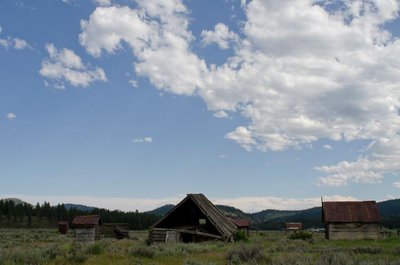
The first thing we noticed was the quiet. Even the wind seemed muted as it whipped through the tall grass. Five friends had traveled 340 miles east from Eugene to find the ghost town of Whitney, and now we stood at a dirt crossroad, reading a sign with a horse-drawn carriage painted next to a steam engine. “Rails of the Sumpter Valley R. R. reached Whitney Valley June 1, 1901,” we read, squinting in the hot July sun. “At one time 150 people called Whitney their home. When the railway was abandoned in 1947, the town closed down.”
Seeking out ghost towns in Oregon is the perfect summer activity because it has so many avenues for the imagination, whether it’s for the history buff, the sociologist, the environmentalist, the artist, the explorer or even the seeker of the supernatural. These ruins of the Western Frontier are littered across the state — a quick internet search shows at least 80 identified abandoned villages — from as far flung as Whitney (and neighboring Sumpter) to as nearby as the former mining town of Bohemia outside Cottage Grove; visit during Bohemia Mining Days (7/18-7/21), a celebration of the town’s history, for live music, a carnival, horse-drawn trolley rides, a beard-growing contest, a “Cherry Pit Spittin’ for Distance” contest and more.
The most famous of Oregon’s ghost towns is Shaniko in Wasco County; however, the city still has about two dozen residents and thus, technically, is not a ghost town. “Real” ghost towns prime for visiting are Susanville in the Blue Mountains (where George Armstrong dug up a 80.4-ounce gold nugget in 1913), Josephine County’s Golden (the site of many paranormal investigations complete with a rustic chapel and small cemetery) or Central Oregon’s Richmond (complete with barn, school and church). But before you set off on your own history-chasing adventure, here are some ghost town tips:
Bring a map. No, really, bring a paper map. Yes, smartphones are handy, but ghost towns tend to be remote places for a reason and phone service can be sparse or nonexistent.
Wear closed-toe shoes (see rusty mattress springs below).
Enter at your own risk; many of the structures you will encounter haven’t been structurally sound for decades.
Leave things as you found them.
Do your research. Several ghost towns are protected by federal and state law and thus, tromping through the equivalent of an archeological site could get you into legal trouble. Same goes for sites on private land.
Many adventurers and photographers may scoff at number five. “It’s better to beg for forgiveness than ask for permission,” they will tell you. And luckily for us, this turned out to be true. That day, a four-wheeler barreling down the dirt road toward us broke Whitney’s silence. The driver was a hairdresser in Sisters and her family owned the property. We explained that we just wanted to take pictures; she gave us her blessing to explore and encouraged us to visit the town’s nearby cemetery too.
What is left of Whitney is a cluster of small, wooden buildings that look one huff and puff away from being blown to the earth. No hints remained that the land was ever a “lumber company town,” just a few bunnies hopping in and out of an old outhouse and some rusted mattress springs woven to the caked ground by grasses that had sprung through the coils. The homes showed only the smallest signs of former human habitation: a desk chair, some cans of soup and empty glass bottles.
We piled back into our truck and barreled up the road to the town’s cemetery. Nestled in a pine grove atop a hill, it was difficult to say how many plots there were because most were hidden under a layer of pine needles. One visible headstone read “Mina Marie Hale, Jan. 15, 1910, April 27, 1913.” The little girl had passed nearly 100 years before. From what? we wondered. Influenza, small pox, hardship? Then the sky grew dark, lightning flashed through the pines and the low rumble of thunder rattled up the hill like an approaching bobcat. We humbly took that as a sign that our ghost town adventure was coming to a close and it was time to find a camping spot.
For more information about Oregon’s ghost towns, see Philip Varney’s Ghost Towns of the Pacific Northwest: Your Guide to the Hidden History of Washington, Oregon, and British Columbia or visit ghosttowns.com.